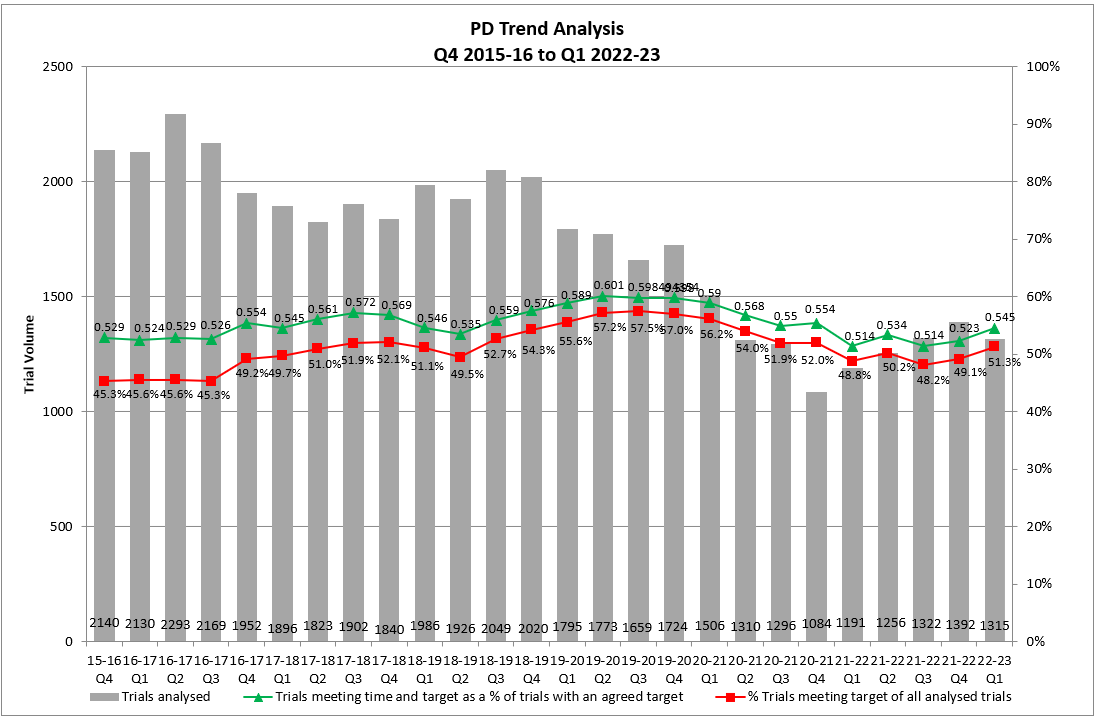Data on performance in initiating and delivering clinical research

The NIHR analyses data submitted each quarter to the Performance in Initiating and Delivering Clinical Research (PID) exercise to understand how quickly providers of NHS services are recruiting patients to clinical trials and how they are performing against their contractual requirements.
We analyse trends over time to understand the performance of the NHS as a whole. In particular we look at:
- how quickly participants are recruited once a study is set up (time between date site selected and date first participant recruited)
- how many clinical trial participants are rQecruited to time and target
We publish a comparison table showing the performance of all NHS organisations that submit to the PID exercise, and trend analyses showing performance across the country as a whole.
Providers of NHS services with NIHR contracts are required to publish their organisation’s performance data on their website.
Performance in initiating clinical research
This graph shows the trend of the time interval between the date that a site was selected for a clinical trial and the date that the first participant was recruited to the trial, for providers of NHS services that hold an NIHR contract.

The number trials analysed in a given quarterly submission is shown as bars on the graph, and the number of sites whose data were analysed is included in square brackets on the x axis beneath each quarter. The first quarter reported is Q4 2016-17, which includes 1,777 trials at 214 sites. The final quarter reported is Q1 2021-22, which comprises 3,266 trials at 210 sites.
The average time between date site selected (DSS) and date first patient recruited (FPR; red data points) has remained largely consistent during the four year period shown in the graph, with a mean ranging from 66 days to 93 days and a median ranging from 44 to 77 days. The average number of days until the first participant was recruited has increased overall during the last four quarters (Q2 20-21 to Q1 21-22).
Also shown are the deciles and quartiles for average recruitment times, to indicate the spread within the data. The longest recruitment time reported was 206 days in Q3 2020-21, and the shortest reported was 9 days in Q3 2020-21.
N.B. While submissions are quarterly, the scope of data submitted is a rolling 12 months of data.
Performance in delivering clinical research
This graph shows the percentage of commercially sponsored clinical trials that met their target number of trial participants during the life of the study.

The number trials analysed in a given quarterly submission is shown as bars on the graph, and the number of sites whose data were analysed is included in square brackets on the x axis beneath each quarter. The green data points indicate the proportion of trials that met targets for speed of participant recruitment (time) and target number of participants recruited, shown as the proportion of trials that had agreed targets ('agreed target' means there is both a target number of participants, and a target date to recruit).
The first quarter reported is Q4 2015-16, which includes 2,140 trials with 52.9% of the targets being met. The last reported quarter is Q1 2021-22, which includes 1,191 trials with 51.4% of targets being met.
Not all trials reported have an agreed target number of participants, so also shown are the percentage of targets met out of all trials reported (red data points). For Q4 2015-16, this percentage is 45.3%, and for Q1 2021-22 this is 48.8%.
The percentage of targets met (out of trials with a target reported) have remained largely consistent over time, with a high of 60.1% in Q2 2019-20 and a low of 51.4% in Q1 2021-22. The number of trials reported has ranged from 1,084 in Q4 2020-21 to 2,293 in Q2 2016-17, and has seen a decline since Q4 2018-19 (not shown on graph).
N.B. While submissions are quarterly, the scope of data submitted is a rolling 12 months of data.
We also publish a summary of annual data on the performance in initiating and delivering clinical research exercise, showing data by quarter each year for a number of indicators.
Comparable performance data
We collate and publish data from the more than 200 providers of NHS services that submit data on initiating and delivering clinical research.
This data allows organisations to compare their performance against that of similarly sized providers and collaborate to improve. The data also helps drive increases in the number of patients that have the opportunity to participate in research and enhances the nation’s attractiveness as a host for research.
As of 2018, improvement in clinical trial performance and reducing site set up and participant recruitment time is no longer assessed with a 70 day benchmark. Instead, analyses focus on transparency, accuracy, and meeting sponsor expectations.
Data for each NHS provider
The Department of Health and Social Care requires providers of NHS services to publish on a quarterly basis data on:
- initiation of clinical trials
- recruitment to time and target for commercial contract clinical trials.
This information is published by each provider on their website. We’ve collated in a list details of where each provider has published their data.
Read more about transparency in clinical trial initiation and recruitment.
If you have any questions regarding the PID exercise, contact the NIHR Clinical Trial Performance team on CTP@nihr.ac.uk.
